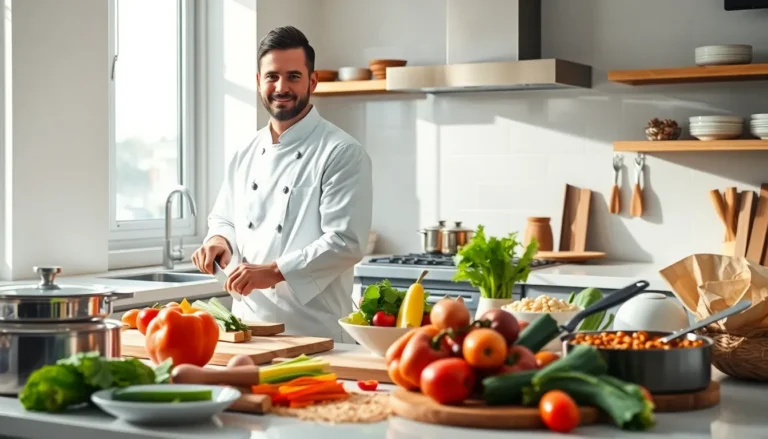Table of Contents
ToggleGreek cooking isn’t just about throwing ingredients together; it’s an art form that marries tradition with flavor. From the sun-kissed shores of the Aegean to bustling city markets, these techniques have been perfected over generations. Whether it’s the sizzle of grilled souvlaki or the slow simmer of a rich moussaka, each method tells a delicious story that’s hard to resist.
Overview of Greek Cooking Techniques
Greek cooking techniques showcase a rich blend of flavors and traditions. Grilling remains a foundational method, enhancing dishes like souvlaki and octopus. Roasting also plays a prominent role, often seen in preparing lamb and vegetables, creating deep, savory tastes.
Baking, particularly in creating desserts such as baklava, demonstrates precision and skill. Boiling and simmering frequently appear in dishes like soups and stews, allowing flavors to meld and develop over time. Steaming, while less common, preserves nutrients and texture in seafood and vegetables.
Frying provides a crispy texture, essential for dishes like spanakopita. Sautéing involves quick cooking over high heat, beneficial for preparing garlic, herbs, and vegetables.
Preservation techniques also hold significance in Greek cooking. Pickling enhances flavors and extends the shelf life of vegetables such as olives and capers. Marinating allows meats to soak up spices and oils, improving flavor complexity.
Presentation techniques elevate dishes visually, with vibrant colors and fresh garnishes. Cultural traditions often dictate the serving methods and portion sizes, reflecting regional diversity.
Incorporating seasonal ingredients aligns with traditional practices, ensuring freshness and enhancing taste profiles. Each method complements the others, culminating in the unique experience of Greek cuisine that draws from its storied past.
Traditional Cooking Methods
Greek cooking relies on various traditional methods that enhance flavors and textures. Predominant techniques like roasting and grilling exemplify the simplicity and richness of Greek cuisine.
Roasting and Grilling
Roasting plays a crucial role in intensifying flavors in Greek dishes. Lamb, often prepared with aromatic herbs, absorbs the seasonings during roasting. Grilling, on the other hand, is essential for dishes like souvlaki and octopus, imparting a smoky char that elevates the meal. Both methods favor straightforward ingredients, allowing the natural qualities of meats and vegetables to shine. Seasonal produce, when grilled or roasted, showcases its freshness and regional uniqueness.
Stewing and Braising
Stewing and braising offer deep flavors and tender textures in Greek cuisine. These techniques combine ingredients like beef, chicken, or vegetables with rich sauces, creating comforting dishes. Slow cooking melds flavors, making dishes like stifado tantalizing and hearty. Ingredients often include tomatoes, onions, and a variety of spices that enhance the overall taste. These methods are particularly favored during colder months, reflecting the tradition of sharing warm meals within families. Each technique preserves the integrity of the ingredients while building layers of flavor.
Ingredient Preparation Techniques
Ingredient preparation techniques form the backbone of Greek cooking. They ensure flavors meld appropriately and maintain the essence of every dish.
Marinating and Seasoning
Marinating meats and vegetables enhances their flavor and texture. It often involves olive oil, lemon juice, and a medley of herbs like oregano and thyme. The marinade not only infuses ingredients with taste but also tenderizes them. For example, souvlaki is commonly marinated before grilling, creating a juicy and aromatic result. Seasoning, which incorporates salt and spices, plays a crucial role in balancing flavors. Fresh ingredients, especially herbs, elevate dishes and reflect the vibrant character of Greek cuisine.
Fermenting and Preserving
Fermenting and preserving ingredients extend their shelf life and enhance taste. Greek cuisine often employs techniques like pickling vegetables and fermenting yogurt. Pickling cucumbers and olives introduces tangy flavors that complement various dishes. Meanwhile, yogurt fermentation creates the popular tzatziki sauce, providing a refreshing contrast to grilled meats. Preservation methods result in concentrated flavors that enhance stews and dips. Both techniques represent a time-honored practice, allowing cooks to utilize seasonal produce throughout the year.
Regional Variations in Techniques
Greek cooking showcases diverse techniques rooted in regional traditions and local ingredients, adding depth to each dish’s flavor profile. Techniques vary significantly across the country.
Techniques from Crete
Cretan cuisine focuses on simplicity and freshness, emphasizing local ingredients. Grilling seafood like octopus stands out as a popular technique, offering a smoky flavor. Olive oil plays a crucial role, often used in dressings and marinades. Slow-cooking methods highlight the natural taste of meats and vegetables, especially in recipes like lamb with wild greens. Seasonal herbs, such as rosemary and sage, enhance dishes, bringing out unique aromas. Additionally, the use of grains and legumes reflects the region’s agricultural strength, contributing to hearty stews and salads.
Techniques from the Cyclades
Cycladic culinary techniques center on freshness and bold flavors. The region favors sun-dried ingredients to amplify taste, particularly herbs and tomatoes. Baking is prevalent, with iconic dishes like fava and baked vegetables, showcasing a love for rustic preparations. Grilling is also popular, often seen in traditional dishes served with flavorful marinades made from local olive oil and fresh lemon juice. Right from the sea, fishing dictates many culinary practices, ensuring meals remain fresh and seasonal. The emphasis on local cheeses, prepared through traditional methods, enhances flavors in several regional dishes.
Modern Adaptations of Greek Cooking Techniques
Modern Greek cuisine embraces traditional techniques while integrating contemporary elements. Chefs often utilize sous-vide cooking, enhancing precision and flavor infusion in dishes like lamb. This method complements the classic slow-roasting technique, ensuring tender and juicy results.
Innovative grilling techniques involve using flavored wood chips to impart unique smokiness. By experimenting with various marinades, chefs can achieve new flavor profiles that align with traditional ingredients. Additionally, using high-heat methods for baking creates crispy textures in dishes like spanakopita, blending modern efficiency with time-honored recipes.
Fresh, seasonal ingredients remain central, yet contemporary chefs explore alternative produce to create unique interpretations of Greek classics. They might employ non-traditional grains, such as quinoa or farro, in salads and side dishes. This adaptation showcases how diverse dietary preferences can exist alongside traditional offerings.
Fermentation continues to play a significant role, with cooks now crafting homemade fermented condiments. These ingredients elevate the flavor of dishes while aligning with health-conscious trends. Yogurt, for example, is often paired with seasonal fruits in creative desserts, adding a modern twist to a classic foundation.
Modern kitchen technology, like air fryers and pressure cookers, complements traditional frying and stewing methods. These devices streamline cooking processes, making it easier to prepare authentic meals without sacrificing flavor or texture. As these innovations emerge, they enhance the overall dining experience while maintaining the spirit of Greek culinary heritage.
Through this blend of tradition and innovation, Greek cuisine remains vibrant and relevant, providing a taste of history alongside modern culinary advancements.
Greek cooking techniques embody a rich tapestry of tradition and flavor. The methods explored not only enhance the taste of each dish but also preserve the essence of Greek culinary heritage. From grilling to baking each technique plays a vital role in creating memorable meals that celebrate the use of fresh, seasonal ingredients.
As modern adaptations continue to emerge Greek cuisine remains dynamic and relevant. Chefs embrace innovative techniques while respecting time-honored practices ensuring that the heart of Greek cooking thrives. This blend of tradition and innovation invites everyone to experience the vibrant flavors and cultural richness that define Greek cooking.



